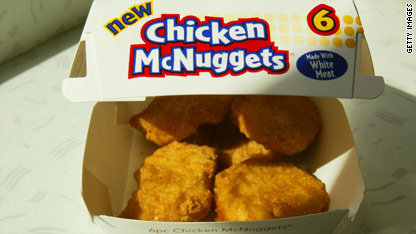
All McDonald’s nuggets are not created equal.
U.S. McNuggets not only contain more calories and fat than their British counterparts, but also chemicals not found across the Atlantic.
CNN investigated the differences after receiving a
blog comment asking about them.
By contrast,
British McNuggets (170 calories, 9 grams of fat, 1 gram of saturated fat for 4 pieces) lists neither chemical among its ingredients.
“I would certainly choose the British nuggets over the American” says
Ruth Winter, author of “A Consumer’s Dictionary of Food Additives.”
McDonald’s says the differences are based on the local tastes: In the United States, McNuggets are coated and then cooked, in the United Kingdom, they are cooked and then coated. As a result, the British McNuggets absorb less oil and have less fat.
"You would find that if you looked at any of our core food items. You'd see little, regional differences," says Lisa McComb, who handles global media relations for McDonald's, which has more than 32,000 restaurants in 117 countries. "We do taste testing of all our food items on an ongoing basis."
One apparent difference is only a matter of labeling, according to McComb. U.K. McNuggets list ground celery and pepper, which are labeled simply as "spices" in the United States, she says.
Marion Nestle, a New York University professor and author of “What to Eat,” says the tertiary butylhydroquinone and dimethylpolysiloxane in the McNuggets probably pose no health risks. As a general rule, though, she advocates not eating any food with an ingredient you can’t pronounce.
Dimethylpolysiloxane is used as a matter of safety to keep the oil from foaming, McComb says. The chemical is a form of silicone also used in cosmetics and Silly Putty. A
review of animal studies by The World Health Organization found no adverse health effects associated with dimethylpolysiloxane.
TBHQ is a preservative for vegetable oils and animal fats, limited to .02 percent of the oil in the nugget. One gram (one-thirtieth of an ounce) can cause "nausea, vomiting, ringing in the ears, delirium, a sense of suffocation, and collapse," according to “A Consumer’s Dictionary of Food Additives.”
In 2003, McDonald’s launched smaller, all-white-meat McNuggets after a federal judge dubbed the food “a McFrankenstein creation of various elements not utilized by the home cook." Among the ingredients that remained in the new McNuggets: tBHQ and dimethylpolysiloxane.
Christopher Kimball, the founder and publisher of Cook’s Illustrated magazine and host of the syndicated cooking show America’s Test Kitchen, says he suspects these chemicals are required for the nuggets to hold their shape and texture after being extruded into nugget-shaped molds.
“The regulations in Europe, in general, around food are much stricter than the U.S.,” Kimball says.

.png)
.png)
.png)
.png)
.png)
.png)

.png)


.png)

.png)




.png)

.png)

